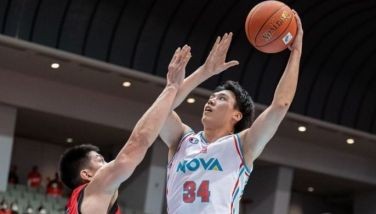Knowing, preventing, and treating stroke
CEBU, Philippines - When CBS Hollywood reporter Serene Branson started talking gibberish while reporting outside Staples Center for a post-Grammy newscast last February 13, she became an instant hit.
Videos of the incident were immediately downloaded and went viral on YouTube (although it was removed just as quickly) and even days after the incident, the airwaves were still filled with discussions on presumptions of what really happened to her.
Neurologists said that she may have had a brief episode of stroke or, as what really happened, simply had a case of migraine. The former, however was an eerie possibility which reflected the alarming increase in incidence of stroke cases among the younger population.
It seems that stroke is no longer a disease of the ageing.
At an American Stroke Association conference last February 9, researchers at the US Centers for Disease Control and Prevention (CDC) revealed that compared to data from 1994-1995, data from 2006-2007 showed a dramatic 51 percent increase in stroke cases among American males aged 14 to 34. While females of similar age range showed a 17 percent increase in cases.
Children aged 5-14 also showed an increase in stroke incidence, with boys showing an increase of 31 percent, while girls showing an alarming increase of 36 percent.
The reasons?
Obesity, smoking, high blood pressure, alcohol abuse, and, yes, diet soda.
The researchers, however pointed out that in order to pinpoint the exact cause for the dramatic increase, further study is needed.
So, what exactly is a stroke and how can we prevent it?
Stroke
Stroke, according to the US National Institutes of Health, is a medical emergency that happens when blood flow to the brain suddenly stops.
Stroke is of two types: ischemic stroke and the more alarming and deadlier hemorrhagic stroke. A third kind, transient ischemic attack or mini-stroke, is short-lived with temporary loss of function (depending on which part of the brain is affected) that resolves within 24 hours. However, all TIA’s must be treated as an emergency case because there will never be a guarantee that the condition will be resolved and function restored.
Ischemic stroke, is simply the absence of oxygen to the brain. This is caused by a block in the arteries that supply the brain with oxygenated blood. The blockage can be caused either by a tumor that impinges on the artery, more like when one pinches a straw, or a narrowing of the arteries due to substances (mostly fats and scar tissue) lodged in its lining.
Hemorrhagic stroke, on the other hand, occurs when a vessel erupts due to high blood pressure or because of an inborn abnormality called arteriovenous malformations, which are abnormally fragile and thin blood vessels in the brain.
Symptoms of stroke
The National Stroke Association has identified several common stroke syndromes, including:
·Sudden numbness or weakness of the face, arm or leg – especially on one side of the body
·Sudden confusion, trouble speaking or understanding
·Sudden trouble seeing in one or both eyes
·Sudden trouble walking, dizziness, loss of balance or coordination
·Sudden severe headache with no known cause
The manifestations, however, would depend on the area of the brain affected by the attack.
Fast: Identifying when stroke occurs
Based on this, a test on identifying a possible stroke incident was formulated, called the FAST Test:
F=FACE: Ask the person to smile. Does one side of the face droop?
A=ARMS: Ask the person to raise both arms. Does one arm drift downward?
S =SPEECH: Ask the person to repeat a simple sentence. Does the speech sound slurred or strange?
T =TIME: If you observe any of these signs, it’s time to call 9-1-1 or get to the nearest stroke center or hospital.
Once these symptoms is observed, the patient must be brought to the hospital immediately, because the longer the patient is deprived of medical care, the more disabling the disease would become.
Lifestyle change
Stroke, however can be prevented by simply avoiding the different lifestyle risk factors. These risk factors would include smoking, being overweight, and drinking too much alcohol.
It was observed that smokers are three times more likely to have stroke than those who don’t smoke, and that even second hand smokers have twice the chances of getting stroke. However, if one ceases to smoke, after five years, the risk of getting stroke is reduced to that of a non-smoker.
As obesity increases blood pressure, accumulation of fats and scar tissue that blocks the arteries would also increase, thus increasing the chances of getting stroke. That is why the National Stroke Association has recommended lower fat diet and for one to include at least 30-minutes of exercises in daily routines like brisk walking and swimming.
Rehabilitating stroke patients
Should one experience stroke, the disabling effects of the disease can be rehabilitated through a multidisciplinary approach that include a physiatrist (doctor of physical rehabilitation), physical therapist, occupational therapist, and speech therapist, to name a few.
Treatment, however would take time as this is like re-teaching the muscles how to work, which can be a tedious yet rewarding endeavor.
Experiencing these deficits can be frustrating on the part of the patient. Imagine not being able to do tasks as simple as saying yes or no. Or to be left confused on what he was expected to do, simply because he could not retain new memories.
The disability that stroke may pose on its victim can be very frustrating, that is why it is very important that in every step of the treatment, the cooperation of the patient and his family is essential.
Rehab not working?
One of the major reasons why some of the patients do not benefit from rehabilitation, most especially with physical therapy, is because the patient refuses to follow the discipline and guidelines that the therapist would impose. The most common violation that most Filipino patients would make is smoking and with his diet.
Many patients insist on continuing to puff, this despite the difficulty that he already is in. He could even hardly breathe yet he can shout at his caregivers just to give him a stick of cigarette.
There are, however, many patients who have recovered and adapted from the disability brought about by the illness. Most of these patients refused to be made dependent by the disease and instead adapted compensation strategies for them to continue to function in as near to normal as possible.
Compensatory trainings and home adaptation
Since treatment and retraining can take a lifetime, patients are instead taught compensatory measures to help them function in as near normal possible despite the presence of the disabilities.
Aside from compensatory trainings on activities of daily living (ADL), patients may also be asked to make their living quarters stroke-friendly. When one used to sleep in the second floor, he may opt to transfer to the ground floor.
In addition, task specific trainings like transferring from the wheelchair to bed, is also practiced. This is done to ensure that the patient is able to perform ADLs independently despite the limitations that the illness might impose.
Stroke can be a very disabling and devastating disease. Many families in the Philippines have lost their income because of this disease. However, it can be prevented and its effects minimized if only we are willing to knock out those disabling habits.
Visit the author’s blog at http://tribong-upos.xanga.com. Sources: American Heart Association (www.heart.org); National Institutes of Health (www.nlm.nih.gov); National Stroke Association (www.stroke.org).
- Latest
- Trending



















